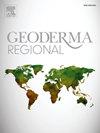硅酸盐粉尘和粪肥的共同添加可改善粗粒土壤的土壤健康指标和作物产量,而不是中等粒度土壤的健康指标和作物产量
IF 3.3
2区 农林科学
Q2 SOIL SCIENCE
引用次数: 0
摘要
硅酸盐岩粉和粪肥混合物越来越多地被认为可以改善作物生长和土壤健康。在土壤中施用硅酸盐岩粉可以捕捉和储存大气中的二氧化碳(作为无机碳),同时也有可能稳定粪肥中的有机物。然而,很少有人研究过岩屑与粪肥之间的协同作用,而确定最佳结合率仍然是个难题。在这里,我们在两种对比强烈的高岭土(粗质砂壤土和中质粉砂壤土)中进行了田间试验,分别使用肉鸡粪便(10 兆克/公顷-1)[100%]、磨细的硅酸盐岩屑(花岗岩)(10 兆克/公顷-1)[100%]以及粪便(7 兆克/公顷-1)+岩屑(3 兆克/公顷-1)[70:粪肥(5 毫克/公顷-1)+石粉(5 毫克/公顷-1)[50:50%]和未加改良的对照组,以研究它们对叶菜类植物(Amaranthus cruentus)和土壤健康指标的影响。尽管粪肥投入量减少了,但粪肥-岩屑混合物的效果优于单一粪肥,因为它提高了蔬菜鲜草产量(19%),并改善了所有土壤健康指标,具体表现在土壤酸度降低、土壤导电率和土壤总碳增加、氮的可利用性和保持率提高、生物可利用钾增加、土壤溶解有机碳损失减少、土壤微生物活动增加以及土壤物理性质(即土壤团粒结构、容重、孔隙度和水渗透性)改善。土壤质地会调节粪便-岩石粉尘的效果,这一点从粗质沙质壤土比中质粉质壤土更好的反应中可以看出。在沙质壤土和淤泥质壤土中,粪肥与石粉的混合比例为[50:50],与单独使用粪肥相比,土壤二氧化碳排放量分别减少了 26% 和 54%。粪肥与石粉的混合比例为 70:30 和 50:50,两者的协同作用效果相似;但是,为了减少土壤中的养分限制,建立一个养分更均衡的系统,同时提高土壤功能和减少二氧化碳排放,我们认为粪肥与石粉的混合比例[70:30]是最佳的。本文章由计算机程序翻译,如有差异,请以英文原文为准。
Co-amendment of silicate dust and manure improves soil health metrics and crop yield in coarser-textured more than medium-textured soils
Silicate rock dust and manure admixtures are increasingly considered to improve crop growth and soil health. Soil application of silicate rock dust can capture and store atmospheric CO2 as inorganic carbon but could also have the potential to stabilize manure-derived organic matter when combined. However, synergies between rock dust and manure have been rarely investigated, while identifying the optimal combination rate remains elusive. Here, we set up a field trial in two contrasting kaolinitic soil (coarse-textured sandy loam and medium-textured silt loam) amended with a modest realistic rate of broiler manure (10 Mg ha−1) [100 %], finely ground silicate rock dust (granite) (10 Mg ha−1) [100 %], and a combination of manure (7 Mg ha−1) + rock dust (3 Mg ha−1) [70:30 %], manure (5 Mg ha−1) + rock dust (5 Mg ha−1) [50:50 %] and an un-amended control to investigate their effects on a leafy vegetable plant (Amaranthus cruentus) and metrics of soil health, and an incubation experiment to monitor soil heterotrophic CO2 emission. Despite a reduction in manure input, the manure-rock dust mixture outperformed sole manure by increasing vegetable fresh herbage yield (by 19 %) and enhancing all soil health metrics, as revealed by the decrease in soil acidity, increased soil EC and soil total C, enhanced N availability and retention, increased bioavailable P, decreased soil dissolved organic C losses, increased soil microbial activity, and improved soil physical properties (viz., soil aggregate, bulk density, porosity, and water infiltration). Soil texture modulates the effects of manure-rock dust, as demonstrated by the better response from coarse-textured sandy loam than medium-textured silt loam soil. Manure-rock dust admixture [50:50] ratio decreased soil CO2 emissions by 26 % and 54 %, respectively, in sandy loam and silt loam soil texture compared to sole manure. The synergistic performance of manure-rock dust admixture at 70:30 and 50:50 ratios was similar; however, to reduce nutrient limitation in the soil towards a more nutrient-equilibrated system while enhancing soil functioning and mitigating CO2 emissions, we adjudged the manure-rock dust [70:30] ratio to be optimal.
求助全文
通过发布文献求助,成功后即可免费获取论文全文。
去求助
来源期刊

Geoderma Regional
Agricultural and Biological Sciences-Soil Science
CiteScore
6.10
自引率
7.30%
发文量
122
审稿时长
76 days
期刊介绍:
Global issues require studies and solutions on national and regional levels. Geoderma Regional focuses on studies that increase understanding and advance our scientific knowledge of soils in all regions of the world. The journal embraces every aspect of soil science and welcomes reviews of regional progress.
 求助内容:
求助内容: 应助结果提醒方式:
应助结果提醒方式:


